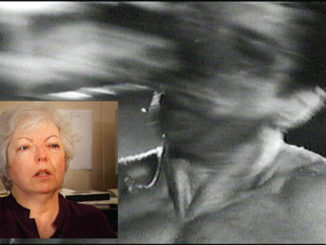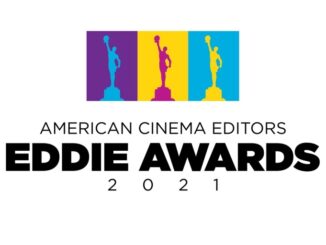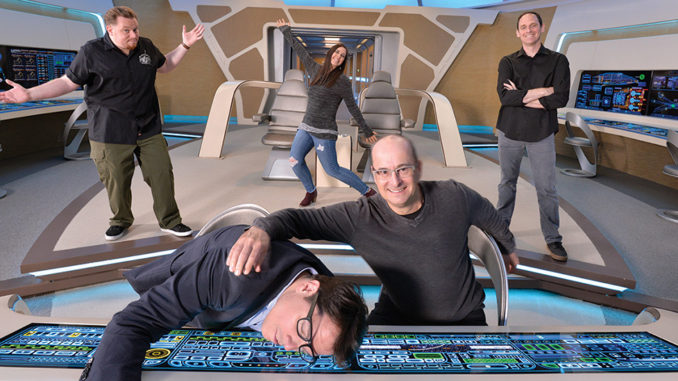
by Michael Goldman • portraits by Martin Cohen
Despite being buried under various deadlines while cutting The Orville, Seth MacFarlane’s sci-fi dramedy series that has its second season premiere in December on Fox, the show’s core editorial team still found time recently to convey the zeitgeist of what they consider to be an exceptionally collaborative editing room. The show tells the sometimes serious and sometimes wacky story of a crew of misfits on a futuristic starship commanded by Captain Ed Mercer, played by MacFarlane.
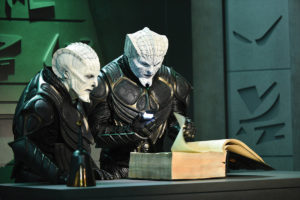

Virtually everything (12 first-season episodes and now 15 episodes for Season 2) is made on the 20th Century Fox Studios lot in Los Angeles, including all work by the editorial group and most other post-production-related functions. And that, the editors suggest, is among the great joys of working on The Orville, even though the show, which has increased in episodes, has moved from three regular picture editors last season to two this year: industry veterans Tom Costantino, ACE, and Scott Powell, ACE.
They feel this way even though The Orville is “an ambitious show for any network,” according to Costantino, and one that featured some 4,000 visual effects shots during its first season, a number likely to increase this year. As many as 7,000 to 8,000 effects shots are estimated for the current season, according to the editorial team. It’s also a show strategically designed to pay homage to the Star Trek franchise, particularly Star Trek: The Next Generation (1987-1994), and walks a delicate creative line by balancing MacFarlane’s satirical look at the Star Trek phenomenon with deeper dramatic themes.
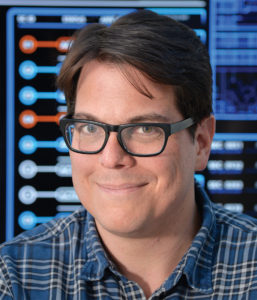
From the point of view of the editors, all of this makes The Orville a show that could only succeed editorially “by emphasizing collaboration and teamwork” in its workflow, according to Powell. “Production and post are all here together at Fox, and that feels good,” he adds. “We aren’t all by ourselves out at a post facility somewhere. Everyone really feels part of a team, and that face-to-face communication is invaluable.”
That team, which Costantino calls “a family, all equals,” includes visual effects editor Rob Kraut, Powell’s assistant Bart Rachmil, Costantino’s assistant Hillary Wills and Kraut’s recently hired assistant, Ian Morabito. They operate out of the show’s editorial offices at Fox, literally steps from the stages, and with plenty of “face time,” as Kraut puts it, with their showrunner MacFarlane.
“Seth will come in to look at an early cut of a show, and go through it, discussing what he intended,” Kraut relates. “But at the same time, he is a collaborative person and wants the best ideas on the screen. He’ll decide what the best idea is, but he will take suggestions from us. So it’s very good to have that time with somebody who has creative oversight on everything, and to have it in an environment where everyone is invited to collaborate.”
The editors feel that because MacFarlane is so hands-on, the show benefits from sticking with two editors rather than a larger group because they all join forces, in a manner of speaking, inside MacFarlane’s mind to achieve his goals for every episode.
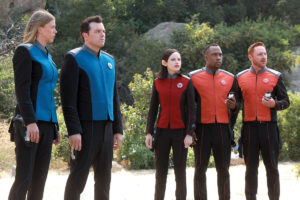
“I think because of the way Seth works, and because we are effectively putting together a 15-hour movie, he has a certain working style that makes it almost better with less people,” offers Costantino. “Since we view it like we are basically making a really long feature, the schedule is set up so he can be involved in all parts of the process. Of course, we have pretty intense working sessions for locking each episode; we aren’t just churning it out. For all these reasons, we use a little bit of a different workflow here.”
Costantino and Powell add that MacFarlane’s detailed interest in editing, visual effects and audio runs so deep that he will often sit with the team and ask them to experiment, even doing temp audio mixes, just so he can have the sensibility “of someone in tune with the picture,” including his evaluation of the soundtrack, visual effects and more, according to Kraut. Costantino elaborates that this approach is particularly helpful to everyone involved in the show’s post process in terms of getting each episode to the finish line.
“Seth’s a human jukebox; he hears audio fields,” Costantino explains. “He knows the boundaries of who does what, and we don’t cross-pollinate. But his input literally helps everybody’s position on the back end to save the edit — and save himself some headaches — because, after all, it’s a marathon and not a sprint.”
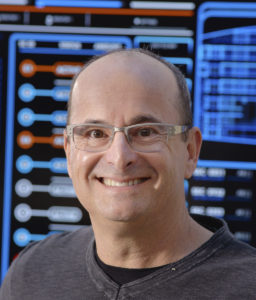
The Orville’s editing home includes seven in-house Avid workstations, plus an iMac used as a dailies transfer station. Thus far, editors have cut the show using Avid Media Composer v.8.9.3, but revealed at press time that the production was in the process of upgrading to version 2018.5. For media storage, the team has been using 45 terabytes of Avid ISIS storage, but recently converted over to the Avid NEXIS storage platform.
Crucial plug-ins include Sapphire and BCC for Avid effects, Mocha for tracking, plus Photoshop and ScriptSync, among others. They also use Shotgun as their visual effects database and various custom apps for translating Avid data into that database. The editors say that ScriptSync — the dialogue search-and-sync tool for Media Composer — is central to helping the team efficiently track and monitor the orgy of assets they have flowing in and out of their system.
“ScriptSync’s scripts are the same as ours, very detailed,” says Wills. “Bart and I do it manually, so we are very careful to catch every reset, every line. We color-code things, so if someone doesn’t finish a sentence, for example, that’s a different color. It is a big help for me; if I’m helping Tom with something, I go to the script before I go to the bin, because it’s so much more detailed and easier to find stuff.”
The Orville also features a well-oiled visual effects pipeline for one of television’s more effects-heavy shows in the sense that it utilizes in-house visual effects editorial and producing teams, as well as a few on-site effects artists, with Kraut serving as a form of glue between their work and what the principal editors are doing along the way.

“In television specifically, the visual effects editor is largely becoming sort of a finishing editor — not in terms of going in and changing edits but, for example, in terms of knowing where and how to help the picture editors solve particular problems,” Kraut explains. “It can be hard on a sci-fi show to time when to have or not have a laser blast, for instance. So a frame here, a frame there; I work with the picture editors to make sure it all gets dialed in. We have to figure out ways to get things done, because sometimes the studio or producers will request things at the end of the process.
“We don’t have the luxury of waiting for an episode to be completely locked before handling visual effects,” Kraut continues. “So we all have to be hyper-focused on detail before it gets to the finishing process. We are sort of an intermediate step. In my role, I have to understand and know how to do assistant editor stuff, I need to know how to edit and I have to understand how to do the finishing process. That allows me to help get the show done in a way that is not going to create back-pedaling due to changes or fixes. If Seth wants to make some changes or fix this or that, we have ways of keeping track of them.”
“The best part about joining The Orville crew is that we have a dedicated visual effects editorial team,” says Morabito. “A lot of the shows on which I’ve worked in the past would saddle the assistant editors with all of the effects — on top of the massive workload they already have. It’s just too much to do, especially on visual effects-heavy shows. Having a dedicated and specialized team ensures that the effects can happen in a more efficient and organically creative manner.”
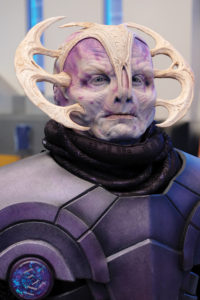
On a show of The Orville’s nature, this kind of enhanced role for the visual effects editor and his assistant is a huge help, the editors say, because the sheer volume of the project would otherwise bog down the editorial process. “We can have up to 600 visual effects shots in an episode,” says Rachmil. “If that was all left to us assistants to turn over per episode, while also turning over temp sound effects and music and all the other traditional stuff, while also dealing with ScriptSync, it would be just about impossible.”
“I can have 350 effects shots to figure out per episode,” adds Wills. “Also, using FileMaker to make my own database to track everything, doing ScriptSync, helping with sound, doing outputs and everything else that we assistants do… Just the fact that Rob is here to manage those things is huge and makes it possible for us to be really efficient.”
All of these issues are made easier, the team insists, by being able to edit the show literally within walking distance of its opulent sets on the Fox lot. “Having our visual effects supervisor on set, just 100 feet away, so we can get an idea of where things are going — that is invaluable,” insists Kraut. “In this modern world where everybody is doing things remotely, there is something to be said about being in the same place with the people with whom you are making the show. Through the entire process, you can interact directly with them and cut through a lot of red tape in terms of getting a creative note.”
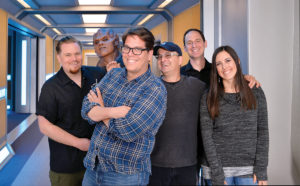
All of which leads to a theme The Orville editorial team is interested in promoting: the nature of the evolving role of editors on the modern, streaming-oriented, multi-platform landscape, even though it is a network show. They may have more to do than ever, but they also have more creative opportunities than usual. Despite being a one-hour network show, for instance, The Orville’s episodes are now longer than average, having a runtime of about 48:10, according to the editors. This is because it is one of a handful of Fox shows that the network recently decided should feature only two commercial breaks as part of an experiment in a new format designed to highlight advertising in premium positions while reducing the overall commercial load — a system called “JAZ Pods.” (JAZ stands for ‘Just A position and Z position’ for commercials, the first and last positions in a typical commercial rotation pod, with no ads in between.)
“We gained five more minutes of television, so we are not making all our decisions based on a clock,” stresses Powell. “That has been very helpful. When you are working on three episodes, all between nine and 12 minutes too long, they can be very hard to cut down because the story is so tight. So getting four-and-a-half extra minutes was great news for us. It’s been liberating.”
The editors say they need all the leeway they can get due to the creative nature of The Orville. For one thing, Costantino says the show is about 30 to 40 percent serialized. “There are serialized elements in each episode,” he explains. “Some of them are on a particular theme, as in Star Trek, and there are evolutions and arcs, but there are also one-offs. It’s kind of the same model as The X-Files in that regard.”

To a degree, the general editing style is most reminiscent of The Next Generation, and indeed, producers Brannon Braga and David Goodman, consultant André Bormanis, and directors Jonathan Frakes and Robert Duncan McNeill all have backgrounds in the Star Trek universe. “Seth wants beautiful cinematic shots that almost harken back to a more classic era of visual effects, to earlier Star Wars and Star Trek stuff,” Kraut adds. “Those kind of big, beautiful, grand shots. He also wants bright colors; he doesn’t want our ships hidden in shadows like you might see on other shows.”
Therefore, adds Costantino, the stylistic challenge for the show’s editorial team is “to walk a line between dynamic and classic. We have to add a modern sensibility for modern audiences, but we still want elegant, graceful camera motion, no whip pans,” he adds. “It’s a very elegant storytelling approach. So that is a balancing act: To honor the Star Trek approach and yet make stuff look pretty.”
Another counterbalance lies between humor and seriousness. Before the show arrived, there was some marketing that made it seem like MacFarlane was attempting something along the spoofy lines of Space Balls (1987) or Galaxy Quest (1999), but in fact, the show features storylines that often have heavy dramatic undercurrents and themes, even while mixing in MacFarlane-style shtick. Powell calls the show “a serious comedy,” and others deem it a “dramedy.” That has not always been an easy equilibrium, the team says, adding that this issue probably accounts for some of the critical indifference to the show when it debuted, regardless of the solid ratings and fan love.
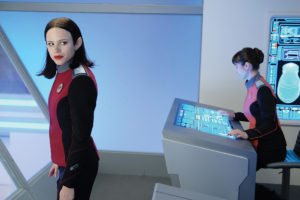
Entering season two, however, they all feel that fine line is becoming more focused and clear. “The first season, the show filled a sci-fi void, but some of the jokes probably were more Family Guy [MacFarlane’s classic animated comedy show],” concedes Costantino. “But I feel the show has largely been stripped of that through our process. Now, it works in the genre, and it meshes with Seth’s working process.
“Seth sort of took some of the humor they had in Star Trek and gave it a bit of moral clarity to demonstrate that you can have humor in sci-fi, and you can have working people doing things like they do in real life — and there can be great humor in that,” Costantino continues. “But there is also great drama in life. So really, we have taken what was already there and refined it. I think the comedy is really organic now. It comes out of situations because we have built history with these characters, and there is a lot of heavy stuff too. But it doesn’t feel imbalanced.”
The bottom line in achieving and maintaining this stasis, according to Powell, is that The Orville benefits from the diverse backgrounds of its editorial team members and the collaborative nature of how they share the workload and manage technical and creative demands. His background, for instance, was largely on action shows, while others came out of the reality TV world — all good training, the editors say, for laboring in the world of The Orville.
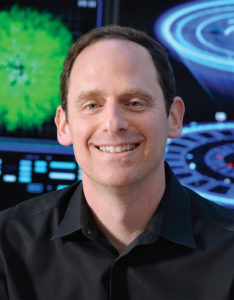
“I think I have a pretty good sense of comic timing, but I always worked mainly on action shows,” acknowledges Powell. “You sort of feel your way through it, and how to balance drama and comedy. We develop the serious themes, but we still like blindsiding people with something from time to time that drops them to the floor laughing.”
His editing partner Costantino adds, “When we are in the room, it is always a balance. Scott hadn’t done any comedy, but he has a wide palette of experience that works for this show. Same thing with me — I’ve got some comedy and dramatic experience, but before that, I was in reality television and news. All that comes into play on this show.
“Seth kind of created a new format, and it took some getting used to,” the editor continues. “When I’m in a dramatic scene, I just try to cut it as a dramatic scene, and when I’m in a comedy scene, I try to cut it as a comedy scene. I have to keep everything within a tonal range, of course, but I play those scenes for what they are, and that is how the show’s tone comes together.”
At the end of the day, that mash-up works great on The Orville. Perhaps because of — or despite — the fact that in space, no one can hear you drop to the floor laughing.




